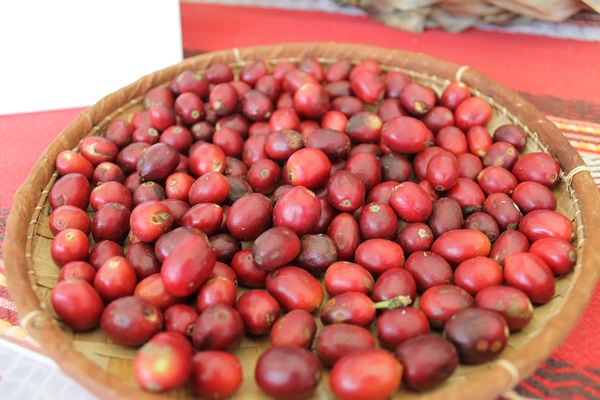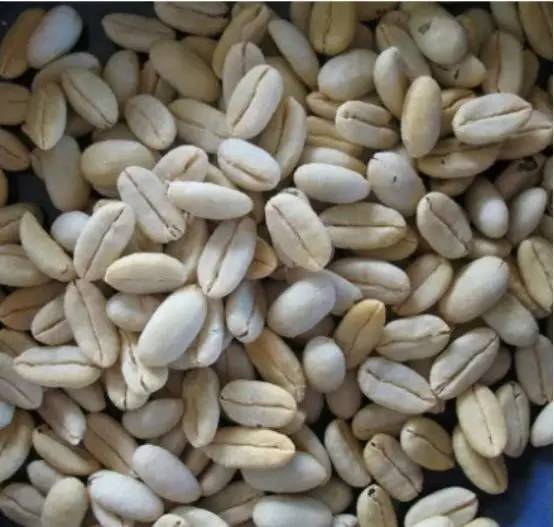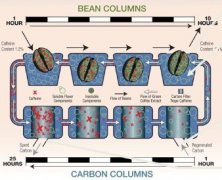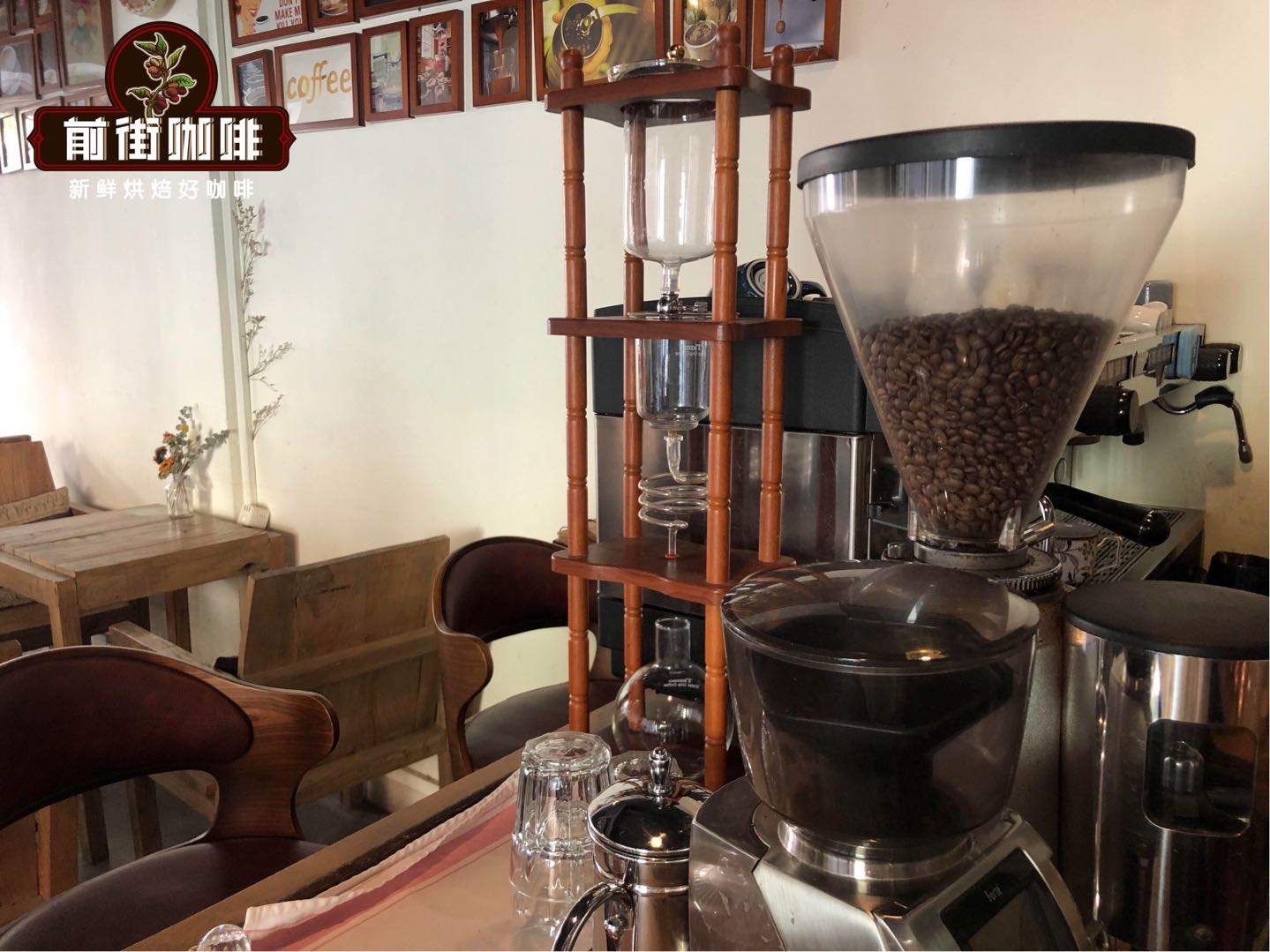Sharp Bourbon / Wild Natural decaf Story: the difference between artificial decaf and Natural decaf

Professional barista communication, please pay attention to coffee workshop (Weixin Official Accounts cafe_style)
Which coffee has the lowest caffeine content? The answer is: pointy bourbon/wild decaf
Pointu Bourbon/Wild Natural Semi Decaf Bourbon Pointu
Coffee Bean King: Pointu Bourbon Pointu, one of the world's rare boutique coffee beans, is less expensive, but the delicate texture makes coffee lovers highly respected. French literary dignitaries favorite 'thousand cups can also sleep well' delicious coffee, in Japan UCC sold alone sharp body bourbon, 100g asking price of 8000 yen, several times in Blue Mountain!
The rice-like long bean body is different from the ordinary round coffee bean. It was discovered by the French in Bourbon Island in 1810. It is a drought-resistant mutant variety of Bourbon species. It is named because of its special bean shape. The pointed Bourbon is a natural species. It does not have the careful fertilization and care of greenhouse cultivation. Therefore, coffee beans are harder, easier to get sick, lower yield, and higher loss rate. But the advantage is that the taste spectrum is elegant, rich in fruit acid aroma, and it is also a rare wild natural semi-decaf coffee, suitable for drinking alone, or before eating, because the taste is very light, only then, the tongue can be sensitive to chew, taste its fine layered sense, rich in taste, fresh and natural aroma, with the fragrance of sunshine wildflowers.

Arabica and Robusta
Coffee is mainly divided into Arabica ( Arabica ), Robusta (Robosta), Liberica ( Liberica ) three varieties. Liberica is less common and will not be described here.
Arabica has less caffeine than Robusta and tastes better, making it a favorite around the world.
1. The aroma level is rich and changeable;
2. The taste is smoother;
The caffeine content is half that of Robusta.
The two great ancestors of Arabica beans were Typica and Bourbon.
Tibika, the name sounds majestic, but in fact it is not so strong. Its constitution is weak, disease resistance is poor, easy to catch rust leaf disease, fruit yield is also less. It is one of Ethiopia's oldest native varieties, and many Arabica are derived from Tibica! Iron than one of the characteristics of the card top leaf for bronze, bean larger, into a sharp oval or thin pointed shape. We are familiar with the Mantenin, Blue Mountain, Elephant Bean, Kona, Yunnan small round beans, etc., are all derived varieties of Tibika.
Bourbon is an ancient and excellent variety juxtaposed with iron pica, and some botanists believe that bourbon may be a variant of early iron pica transplanted to Yemen. Bourbon beans are slightly smaller than iron pica, but yield 30% more than iron pica at later maturity. It is suitable for growing at altitudes above 1200 meters, and the flavor is obviously more prominent than that below 1000 meters. However, Bourbon has a disadvantage that it ends up resting for a year. Bourbon is vigorous and resistant to rust leaf disease better than iron pica, but its flavor is not inferior to it, or even better.
In 1810, Bourbon Island round body beans have a part of the mutation into pointed body beans, this is the famous "pointed body Bourbon", it is characterized by only half the caffeine content, but because of the rare yield after the mutation and like iron Bika disease, it is a pity.

Decaf Coffee <$Artificial Decaf & Natural Decaf
Decaf coffee, as its name suggests, is coffee that contains only trace amounts of caffeine. Coffee contains many ingredients and substances, among which caffeine has a significant impact on the human body. For many coffee drinkers, but the physical condition does not allow caffeine intake, decaffeinated coffee is their "savior", but everything has its pros and cons, after artificial decaffeinated coffee, almost all are rejected as coffee water or bad smell like chemicals.
The average coffee bean moisture content of green beans is 12--13%, caffeine content of 1--1.5%, and according to internationally recognized standards, after decaffeinated green coffee beans, caffeine weight should not exceed 0.1% of green beans, powdered decaffeinated coffee should not exceed 0.3% of weight. This means that in a cup of decaf coffee (usually 170 grams), caffeine should not exceed 5 mg.
Decaf coffee on the market, for cost considerations, mostly by artificial methods to remove the "cause", most of the following four kinds:
ethyl acetate treatment
methylene chloride treatment
Swiss Water Treatment Act
supercritical carbon dioxide process
The first two are most often used in decaf coffee, using ethyl acetate or methylene chloride as a solvent to remove coffee, and most of the coffee flavor is also lost here, the cost is relatively low, but the taste is really bad, or there is a little residue, but according to experts, after roasting, it is almost harmless to the human body. Although the latter 3 and 4 can retain most of the flavor, but because the cost is more than 2- 3 times that of the former two, almost all of them are not used under the cost, and consumers are also extremely difficult to drink the decaf coffee made by these two processing methods.
Commercial decaf coffee is considered by many to have poor flavor because of artificial processing. Arabica contains about 1- 1.5% caffeine in beans. Similar FDA agencies in Europe and the United States have standards for decaf coffee at 0.03%. At present, the content of three natural decaf coffees sold in Europe, America and Japan is basically 0.4--0.9%, which is considered semi-decaf at most.

2. naturally low causal variety
The discovery and cultivation of natural decaf coffee, there are two companies have to say. illy in italy and ucc in japan. They studied a bean called pointy bourbon.
Beginning in 1989, illy, after a failed experiment in Brazil and a surprise transplant to El Salvador, began selling natural semi-decaf espresso capsules of Idillyum in 2008. The yield of raw beans is not high, and Idillyum's formula contains other arabica beans, i.e., non-pure pointy bourbon.
As early as the 1970s, yosho kawashima, an expert on ucc coffee in japan, heard old farmers mention "old and low-caffeine coffee trees may still be alive on french bourbon island" while studying coffee cultivation in el salvador. Then he went, exploring Africa in search of "old, low-caffeine coffee trees." And it came to nothing. A phone call in 2001 brought good news. It is indeed the bourbon piontu (pointy bourbon) that has disappeared for half a century. Pointy bourbon shocked the world with plans to reproduce in its earliest birthplace. A low yield of 700kg in 2006 determined that ucc was priced at 7350 yen per 100g in april 2007, five times more expensive than blue mountain that year.
In the rush of roasters around the world looking to cultivate naturally decaf coffee, one country is one that cannot be overlooked. The development of natural decaf coffee is actually a process of discovering and modifying the genes of coffee trees. Ethiopia, the birthplace of arabica and the repository of arabica's genes, has not yet joined the fray. In 2008, Ethiopian Agriculture Ministry officials claimed to have found natural low-causal varieties. And this matter is false, I do not know whether it is true or false, there is no following.
In the past, scientists have found naturally low-caffeine varieties from Ethiopia, Mozambique or Madagascar and the Skaring Islands. In 2008, Cameroon coffee was discovered as a new variety,"Chalierian Coffee," which is self-pollinated like Arabica and has no caffeine in its seeds.
How to cultivate new coffee varieties with low caffeine, good taste and high yield has become an outstanding study in coffee planting industry in recent years.
Important Notice :
前街咖啡 FrontStreet Coffee has moved to new addredd:
FrontStreet Coffee Address: 315,Donghua East Road,GuangZhou
Tel:020 38364473
- Prev

What kind of coffee is low in caffeine? Recommend Colombian Swiss water treatment decaffeinated coffee beans
Professional baristas please follow the coffee workshop (Wechat official account cafe_style) Swiss Water treatment (The Swiss Water or Water-Only Process): the use of commercially developed efficient treatment methods, there are two major steps. The first step is to pour the raw coffee beans into hot water, which will remove all the flavors from the raw coffee beans.
- Next

Flavor and taste characteristics of Colombian decaf beans? is decaf harmful to health and safety? can you lose weight?
For professional baristas, please pay attention to the coffee workshop (official Wechat account cafe_style). Many people are becoming more and more inseparable from coffee. Nevertheless, the palpitations, stomachaches and insomnia that follow after drinking coffee deter some people from caffeine. Is decaffeinated coffee the solution? Are you worried about palpitations and loss?
Related
- Beginners will see the "Coffee pull flower" guide!
- What is the difference between ice blog purified milk and ordinary milk coffee?
- Why is the Philippines the largest producer of crops in Liberia?
- For coffee extraction, should the fine powder be retained?
- How does extracted espresso fill pressed powder? How much strength does it take to press the powder?
- How to make jasmine cold extract coffee? Is the jasmine + latte good?
- Will this little toy really make the coffee taste better? How does Lily Drip affect coffee extraction?
- Will the action of slapping the filter cup also affect coffee extraction?
- What's the difference between powder-to-water ratio and powder-to-liquid ratio?
- What is the Ethiopian local species? What does it have to do with Heirloom native species?

